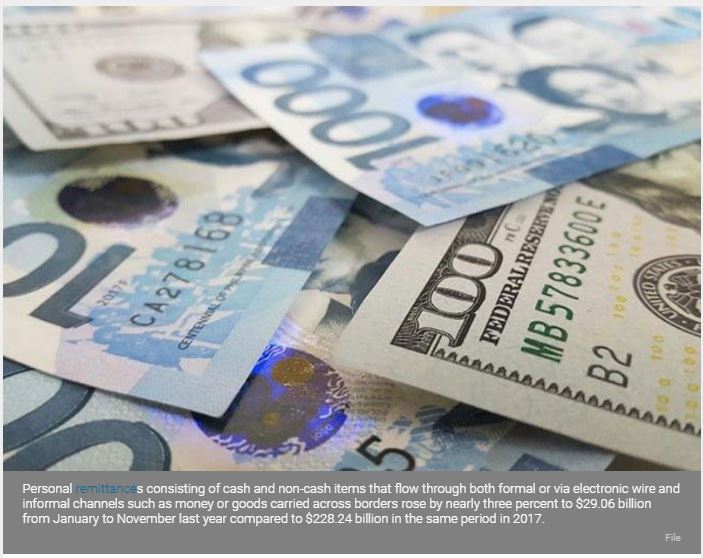Philippines: Remittance growth slows to 2.4% in November
MANILA, Philippines — The growth in remittances by Filipinos abroad eased in November, but remained above the lowered growth target set by the Bangko Sentral ng Pilipinas.
BSP officer-in-charge Maria Almasara Cyd Tuaño-Amador said personal remittances grew by only 2.4 percent to $2.58 billion in November last year from $2.53 billion in the same month in 2017.
This was slower than the eight percent growth – the fastest in six months – recorded in October last year.
Personal remittances consisting of cash and non-cash items that flow through both formal or via electronic wire and informal channels such as money or goods carried across borders rose by nearly three percent to $29.06 billion from January to November last year compared to $228.24 billion in the same period in 2017.
“The growth in personal remittances during the first 11 months of 2018 was supported by remittance inflows from land-based overseas Filipinos with work contracts of one year or more, as well as remittances from sea-based and land-based OFs with work contracts of less than one year which increased by 2.8 percent and four percent, respectively,” Amador said.
Likewise, Amador said cash remittances coursed through banks increased 2.8 percent to $2.33 billion in November from $2.26 billion in the same month in 2017. The rate was slower than the 8.7 percent increase recorded in October.
“The countries that contributed most to the increase for the month were Canada and the US,” Amador.
From January to November last year, Amador said cash remittances went up by 3.1 percent to $26.09 billion from $25.32 billion in the same period in 2017 as inflows from land-based workers managed to rise by nearly three percent to $20.5 billion, while that of sea-based workers grew 4.1 percent to $5.5 billion.
The bulk or 79 percent of the total cash remittances for the first 11 months of 2018 came from the US, Saudi Arabia, United Arab Emirates, Singapore, Japan, United Kingdom, Qatar, Canada, Germany, and Hong Kong.
The BSP has lowered the growth targets for both personal and cash remittances to three percent instead of four percent for 2018 and 2019.
The amount of money sent home by Filipinos abroad usually pick up during the ‘ber’ months or the start of the fourth quarter ahead of the celebration of Christmas.
Remittances usually fuel personal consumption, helping sustain a steady economic growth. The amount of money sent home by overseas Filipinos usually account for 10 percent of the country’s gross domestic product (GDP).
Strong inflows from remittances, earnings of the business process outsourcing (BPO) sector as well as tourism receipts continued to boost the peso that recovered strongly late last year.
The local currency closed 2018 at 52.58 to $1 last year or 5.3 percent weaker than the 49.93 to $1 level in end 2017, the third worst performer in the region. It recovered strongly after hitting its weakest level in 13 years at 54.325 to $1 last Sept. 26.
Source: https://www.philstar.com/business/2019/01/16/1885386/remittance-growth-slows-24-november#LGw5ktJAIl4djM5w.99


 English
English




